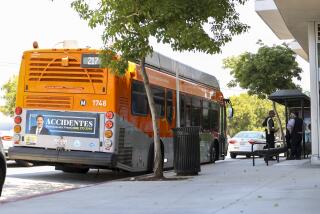Ventura County Railway on Track for History : Transportation: The line today runs freight 13 miles from Oxnard to the Port of Hueneme. It may soon become an official landmark.
- Share via
Over the course of 88 years, the Ventura County Railway has hauled beets to sugar processing plants, Channel Islands cattle to the slaughterhouse, and 225,000 carloads of World War II munitions, supplies and troops bound for the Pacific Theater.
Where the railway once carried July 4th celebrants from Oxnard to a 1905 beach party, today it runs freight along 13 miles of track that reaches from Southern Pacific’s main line in Oxnard to the Port of Hueneme and the U. S. Naval Construction Battalion Center.
“The railroad is integrally linked to the history of Oxnard,” said Madeline Miedema, member of the Ventura County Cultural Heritage Board.
The heritage board recently voted to declare the railway a county landmark, with the designation awaiting the endorsement of the Oxnard City Council.
“I really love the railroad and I really loved the work,” said Frank Navarro, 81, of Oxnard, a 25-year employee who handled everything from track repairs to locomotive operation. “It helped build this city.”
Incorporated in 1903 as the Bakersfield & Ventura Railway Co., the railroad represents the remnants of a once-grandiose plan to build a rail line from a shipping wharf at what is now the Port of Hueneme to the San Joaquin Valley, and from there to Los Angeles and San Francisco.
According to a historical report submitted to the heritage board, the railway was founded by Fillmore resident John Burson and H. M. Russell. Historians speculate that, had the two men not failed in getting financing for their ambitious project, the Port of Hueneme would have attracted much of the shipping business that ultimately went to the Port of Los Angeles.
The first rail line, paralleling the American Sugar Beet Co.’s drainage ditch from Oxnard to the ocean, was completed at 8:30 a.m. July 4, 1905. The last spike was driven just in time for the train to take residents on an inaugural Independence Day run to a feast at barbecue pits dug on the beach.
In 1911, the cash-pinched railway became the property of the Oxnard brothers, Robert and Henry, who had no interest in out-of-town rights of way or becoming railroad barons. They used their acquisition to fuel the growth of their American Sugar Beet Co., building a network of rail spurs from their sugar processing plant to the Oxnard Plain’s most productive beet fields.
When the automobile became popular, passenger service fell off and was finally stopped on New Year’s Eve, 1926. The railway continued as an indentured servant to the beet trade until the founding of the Hueneme port in 1939.
It was World War II that saw it flourish into one of the most profitable small railroads in the nation. After the Navy commandeered the port, an estimated 150 carloads of construction supplies, weaponry, soldiers and sailors were hauled each day over its tracks for four years.
After the war, Oxnard’s sugar beet industry slowly gave way to the farming of other crops. After phasing out operations in 1958, the American Sugar Beet Co. sold its local holdings, including the railroad, to a four-man partnership that included Martin V. Smith, who now owns the railroad outright.
The railway today is one of more than 400 short-line railroads across the United States, many of them side tracks abandoned as unprofitable by major railroads.
South American bananas and Japanese and European cars have supplanted the Channel Islands cattle as inbound cargo. The railroad’s 14 employees serve about 20 customers, including Smuckers, General Electric and several chemical plants. Strawberries and celery are now the primary crops shipped to market or processing plants via the Southern Pacific’s line.
Most of the relics of earlier times are gone--the oldest rolling stock are three diesel locomotives built in 1956. But on the grounds of the railway’s East 5th Street headquarters sits at least one throwback, an elevated water tower dating back about 75 years that furnished the propellant for the railroad’s steam engines.
“As long as I’m here, I won’t let anyone take that water tank down,” railway President Carmen Chappell said. “That’s part of the past that still survives.”
More to Read
Sign up for Essential California
The most important California stories and recommendations in your inbox every morning.
You may occasionally receive promotional content from the Los Angeles Times.













